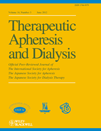Plasma Separation by Centrifugation and Subsequent Plasma Filtration: Impact on Survival in a Pig Model of Sepsis
Financial support: This study relied solely on financial resources of the University of Rostock.
Abstract
The impact on survival of a combination of plasma separation by centrifugation and subsequent plasma filtration was tested in a bacterial sepsis model in pigs. In this animal study 19 pigs were included. Groups II and III received an intravenous lethal dose of live Staphylococcus aureus over 1 h; group I received saline (non-septic control—NC). Groups I and II were treated by an extracorporeal circuit consisting of online centrifugation and subsequent plasma filtration (group II: treated group—TG) for 4 h; group III had no specific treatment (septic control, SC). The observation time was 7 days. All animals of group I (NC) and group II (TG) survived, while all animals of group III (SC) died during the observation time. Extracorporeal therapy with online centrifugation and plasma filtration significantly improved survival in a pig model of sepsis. Further studies with this approach are encouraged.




